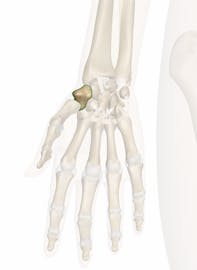The Trapezium Bone
Explore the anatomy and role of the trapezium bone in wrist and hand function with Innerbody's 3D model.

The trapezium bone is one of the eight carpal bones of the wrist. It forms four joints with the surrounding carpals and metacarpals and anchors three hand muscles. The trapezium forms the unique saddle joint with the first metacarpal, allowing the base of the thumb to move freely.
Anatomy
The trapezium is a small, roughly diamond-shaped bone found in the wrist (carpal region) at the base of the thumb. It is one of the eight carpal bones, and is the most lateral bone in the distal row of carpals. Like all carpal bones, the trapezium is a short bone that is just about as wide as it is long. It is surrounded by the scaphoid bone proximally, the trapezoid bone medially, the second metacarpal distally, and the first metacarpal laterally.
The exterior of the trapezium bone has many important landmarks and features. Its dorsal surface is rough and bumpy, providing anchoring points for the ligaments and joint capsules that bind the bones of the hand. The palmar surface of the trapezium is also rough to anchor the origins of the flexor pollicis brevis, abductor pollicis brevis, and opponens pollicis brevis muscles. It features a deep groove on the medial side for the tendon of the flexor carpi radialis muscle and a ridge that forms the lateral wall of the carpal tunnel.
The proximal end of the trapezium is narrow, with a smooth concavity on the medial side for the joint formed with the scaphoid bone and a slight ridge on the lateral side continuous with the ridge on the palmar surface. Like the proximal end, the distal end is also narrow with a smooth facet forming a joint with the second metacarpal. The medial surface is mostly smooth, as it is dominated by the concavity that forms the joint with the scaphoid and a flat facet that forms a joint with the trapezoid bone. Finally, the lateral surface is rough on its proximal end, but features a smooth, saddle-shaped concavity on its distal end that form a joint with the first metacarpal.
Physiology
The trapezium plays several key roles in the function of the wrist and hand. It forms two intercarpal joints with the scaphoid and trapezium bones, which help to increase the flexibility of the hand and wrist. The trapezium also forms two carpometacarpal joints with the first and second metacarpals. The first carpometacarpal joint is a unique saddle joint that allows the first metacarpal to move in a circle, greatly increasing the range of motion of the thumb. This joint is directly responsible for opposition of the thumb, a motion which allows humans to hold things with our hands. The second carpometacarpal joint is a planar joint that allows gliding of the second metacarpal and increases the mobility of the index finger. Third, the trapezium anchors the origins of the abductor pollicis brevis, flexor pollicis brevis, and opponens pollicis brevis muscles that help to move the thumb.


